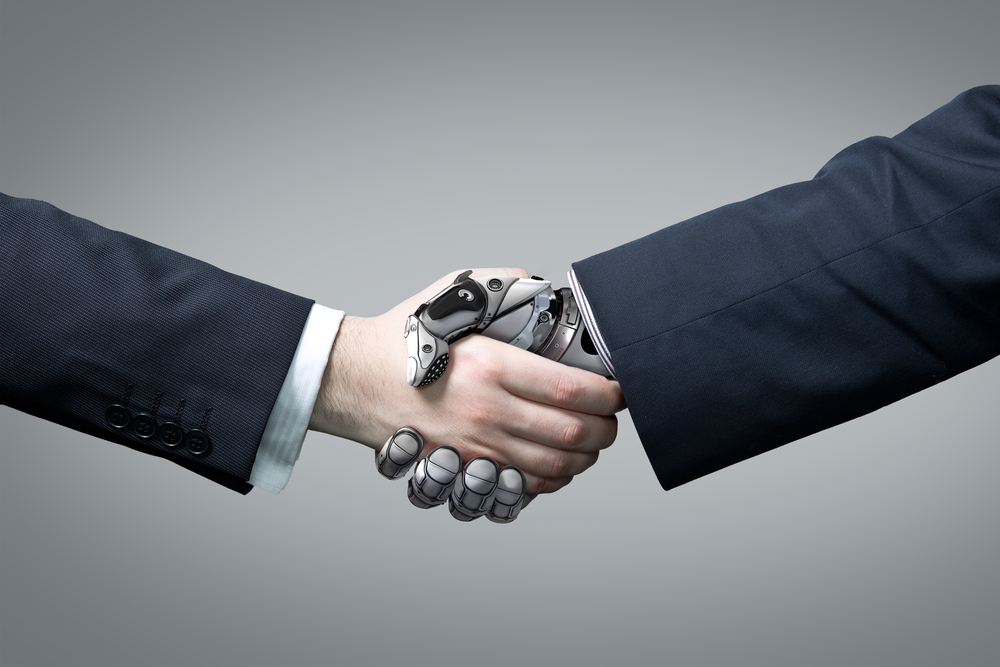Within the next few months, diners at a leading restaurant in Singapore will experience something novel in its service: dishes will no longer be delivered by human waiters, but instead be flown to their tables.
The ‘flying waiters’ are actually autonomous drones, but this is more than a catchy gimmick designed to capture headlines. Once in service, restaurant employees will no longer have to rush dishes between the kitchen and the dining area – a process that is expected to boost staff productivity by 25%.
This is a small but high-profile glimpse into the future of the workforce – one where humans and machines will increasingly work side by side in a trend called ‘intelligent automation’.
>See also: Humans vs robots: the battle for the workplace
Robots have been working on factory production lines for decades, but as the restaurant example shows, they’re now starting to play a role in other parts of the economy, such as the service sector.
The thrust behind this latest leap in automation is down to advances in digital technology. An increasing number of business processes involve software, which enhances their scope for automation. The other developments, which will support this trend, are the advancements in artificial intelligence.
Intelligent automation is not a quest to replace people in the workforce. Instead, it is more about changing the way businesses operate by complementing and augmenting human capabilities, such as cognitive and social skills, with intelligent machines and software.
Intelligent automation was one of five trends picked up in Accenture’s 2016 Technology Vision report. The other four were ‘liquid’ workforces that are adaptable and responsive, the platform economy where new business models are enabled and interconnected, predictable disruption, and digital trust where advanced security features are incorporated.
A human-machine partnership
Machines can help people become more efficient as they can take on tasks that are repetitive, mechanistic, dangerous, or which require rational and very precise data analysis.
Developments in artificial intelligence are another step in this journey, bringing levels of precision, accuracy and sometimes even objectivity – which can be difficult for humans in some cases, especially when vast amounts of data are involved.
With technological change comes a number of new opportunities. Workers will ultimately have the chance to build on or learn new skills, ensuring that businesses, and the latest forms of technology they are harnessing, continue to run smoothly.
Effectively, this will liberate people to do what they do best, which is to focus on creative and cognitive tasks.
Furthermore, this partnering of humans with machines is set to drive higher productivity and improve scale, quality and business adaptability. In fact, Accenture is forecasting 30% to 40% employee productivity gains over the next three to five years – even in already heavily automated functions.
And intelligent automation is already making inroads. For example, in the finance sector natural language processing is being deployed to root out fraud and to support compliance procedures.
The police are starting to use computer vision for facial recognition. The healthcare sector uses it for knowledge representation. This means crunching vast amounts of data to extract insights to improve productivity and patient care.
Many manufacturing plants are also moving towards an age of collaborative working alongside machinery. The introduction of robots that have multi-function grippers, for example, means machinery can autonomously handle unpacked and specially shaped foods or even scan products real-time as they travel down the production line ensuring uniformity.
Strong investment flows
As highlighted by these examples, there is a growing interest in intelligent automation. Accenture’s 2016 survey found that 70% of corporate executives are planning to significantly increase their investments in AI-related technologies compared with two years ago, and 55% are planning to use machine learning and embedded AI solutions extensively.
One of the big drivers behind this trend is the fear of being disrupted by competitors. In that vein, the survey found that 82% of executives believe their organisations need to reinvent themselves before their business models are seriously challenged by competitors. Intelligent automation has emerged as a key enabler behind this drive for transformation.
Being able to not only succeed but thrive as a business in today’s digital world is a feat that will not be managed purely by absorbing increasing amounts of technology, or as some worry, replacing people with robots.
>See also: Myth busting: why automation software will create, not replace, human jobs
Instead, we have reached an age where businesses and enterprises must now focus on enabling people to achieve more with technology. This will inevitably involve new ways of working and cultural shifts, from embedding new corporate cultures to updating business models and the processes that support them.
However, most importantly it is crucial that workforces are fully onboard and engaged with a business’s digital transformation. This includes keeping skills up to date so that staff can be comfortable making use of the tools behind intelligent automation, while also ensuring they continue to feel fully involved in the new ways of working.
We may be living in an era with a technological focus but the most successful leaders will in fact be those who place their people first. Ultimately this means moving towards a different kind of workplace – one that ensures people can easily adapt to working alongside machines and artificial intelligence.
Sourced from Emma McGuigan, MD at Accenture's Technology Group







